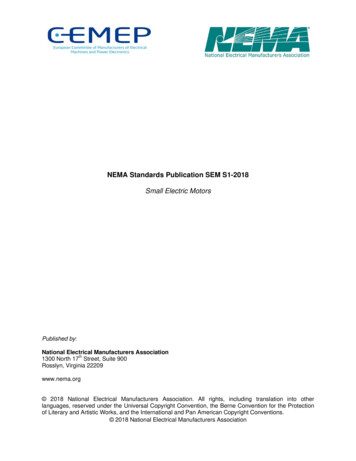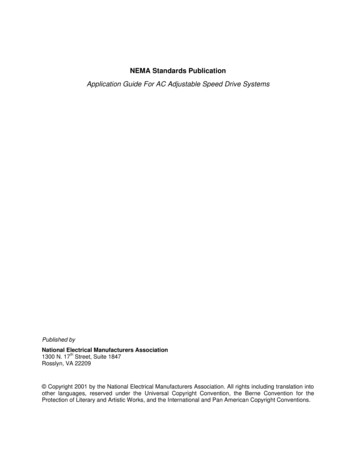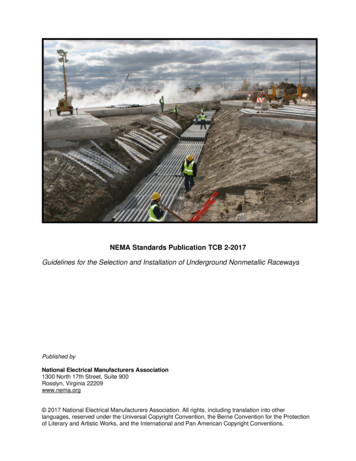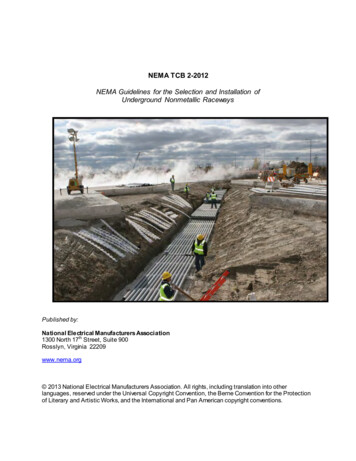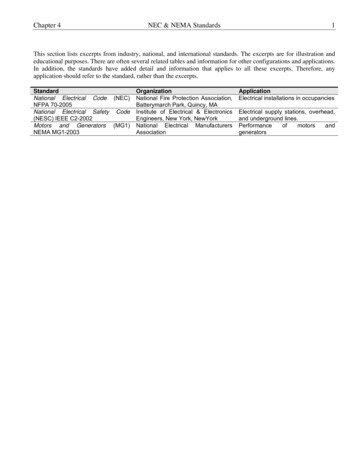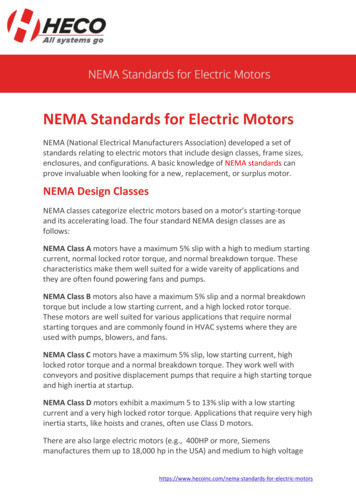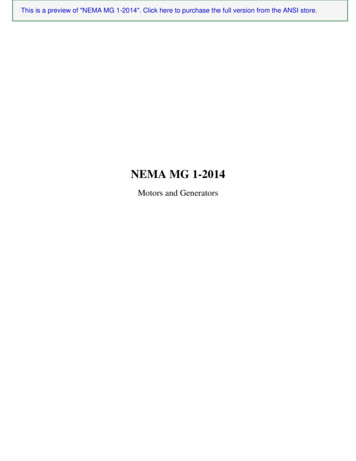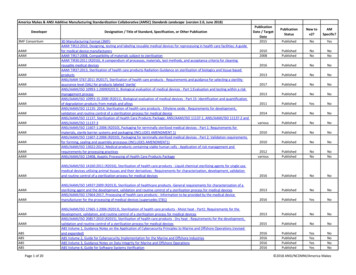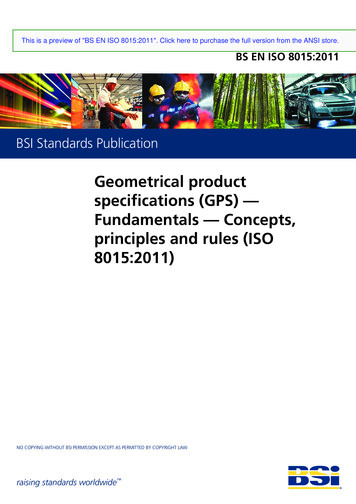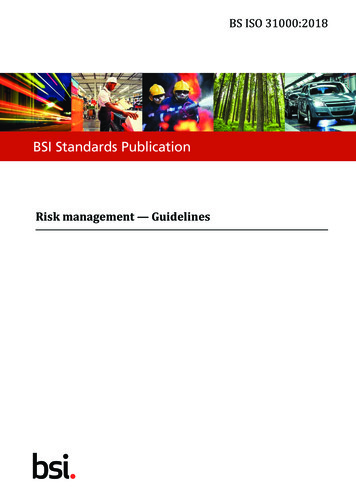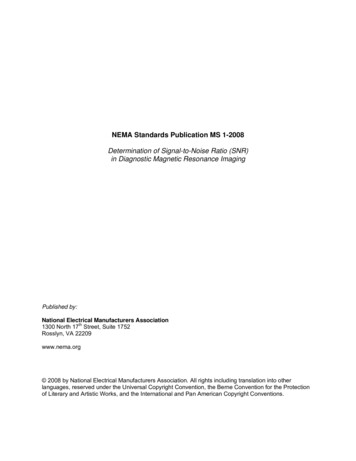
Transcription
NEMA Standards Publication MS 1-2008Determination of Signal-to-Noise Ratio (SNR)in Diagnostic Magnetic Resonance ImagingPublished by:National Electrical Manufacturers Association1300 North 17th Street, Suite 1752Rosslyn, VA 22209www.nema.org 2008 by National Electrical Manufacturers Association. All rights including translation into otherlanguages, reserved under the Universal Copyright Convention, the Berne Convention for the Protectionof Literary and Artistic Works, and the International and Pan American Copyright Conventions.
NOTICE AND DISCLAIMERThe information in this publication was considered technically sound by the consensus of personsengaged in the development and approval of the document at the time it was developed.Consensus does not necessarily mean that there is unanimous agreement among every personparticipating in the development of this document.NEMA standards and guideline publications, of which the document contained herein is one,are developed through a voluntary consensus standards development process. This processbrings together volunteers and/or seeks out the views of persons who have an interest in thetopic covered by this publication. While NEMA administers the process and establishes rulesto promote fairness in the development of consensus, it does not write the document and itdoes not independently test, evaluate, or verify the accuracy or completeness of anyinformation or the soundness of any judgments contained in its standards and guidelinepublications.NEMA disclaims liability for any personal injury, property, or other damages of any naturewhatsoever, whether special, indirect, consequential, or compensatory, directly or indirectlyresulting from the publication, use of, application, or reliance on this document. NEMAdisclaims and makes no guaranty or warranty, express or implied, as to the accuracy orcompleteness of any information published herein, and disclaims and makes no warranty thatthe information in this document will fulfill any of your particular purposes or needs. NEMAdoes not undertake to guarantee the performance of any individual manufacturer or seller’sproducts or services by virtue of this standard or guide.In publishing and making this document available, NEMA is not undertaking to renderprofessional or other services for or on behalf of any person or entity, nor is NEMAundertaking to perform any duty owed by any person or entity to someone else. Anyone usingthis document should rely on his or her own independent judgment or, as appropriate, seekthe advice of a competent professional in determining the exercise of reasonable care in anygiven circumstances. Information and other standards on the topic covered by this publicationmay be available from other sources, which the user may wish to consult for additional viewsor information not covered by this publication.NEMA has no power, nor does it undertake to police or enforce compliance with the contentsof this document. NEMA does not certify, test, or inspect products, designs, or installations forsafety or health purposes. Any certification or other statement of compliance with any healthor safety-related information in this document shall not be attributable to NEMA and is solelythe responsibility of the certifier or maker of the statement.
NEMA MS 1-2008Page iCONTENTSPagePreamble .iiForeword.iiiRationale.ivScope.ivDEFINITIONS . 1Specification Volume . 1Specification Area. 1Measurement Region of Interest (MROI) . 1Image Signal. 1Image Noise. 1Image Signal-to-Noise Ratio. 1Image Artifact. 1Voxel Dimensions. 1Real Image . 2Magnitude Image. 2METHODS OF MEASUREMENT . 3Test Hardware . 32.1.1 Size of the Signal Producing Volume. 32.1.2 RF Coil Loading Characteristics. 32.1.3 MR Characteristics of the Signal Producing Volume . 32.2Scan Conditions . 32.3Measurement Procedure . 42.3.1 Image Signal Determination. 42.3.2 Procedures to Evaluate Image Noise . 42.3.3 Procedure to Determine SNR . 9Section 3 RESULTS . 103.1Reporting of Results . 103.1.1 Geometric and Phantom Information . 103.1.2 Data Acquisition Parameters. 103.1.3 SNR Results. 113.1.4 Reconstruction Parameters. 113.1.5 Additional Data . 113.1.6 Repeatability Data. 113.1.7 Sources of Error . 11Section 11.11.21.31.41.51.61.71.81.91.10Section 22.1AppendicesAAn Alternative Measure of Noise Standard Deviation . 12BTableChanges to Standard. 133–1FiguresData Acquisition Parameters . 101–1A Schematic Showing the Relative Location of Defined Terms . 22–1A Schematic Showing Example Background Noise Measurement Region Locations forMethod 4. 9 Copyright 2008 by the National Electrical Manufacturers Association
NEMA MS 1-2008Page iiPreambleThis is one of a series of test standards developed by the medical diagnostic imaging industry for themeasurement of performance parameters governing image quality of magnetic resonance (MR) imagingsystems. These test standards are intended for the use of equipment manufacturers, prospectivepurchasers, and users alike.Manufacturers are permitted to use these standards for the determination of system performancespecifications. This standardization of performance specifications is of benefit to the prospectiveequipment purchaser, and the parameters supplied with each NEMA measurement serve as a guide tothose factors that can influence the measurement. These standards can also serve as referenceprocedures for acceptance testing and periodic quality assurance.It must be recognized, however, that not all test standards lend themselves to measurement at theinstallation site. Some test standards require instrumentation better suited to factory measurements, whileothers require the facilities of an instrumentation laboratory to assure stable test conditions necessary forreliable measurements.The NEMA test procedures are carried out using the normal clinical operating mode of the system. Forexample, standard calibration procedures, standard clinical sequences, and standard reconstructionprocesses shall be used. No modifications to alter test results shall be used unless otherwise specified inthese standards.The NEMA Magnetic Resonance Section has identified a set of key magnetic resonance image qualityparameters. This standards publication describes the measurement of one of these parameters.EquivalenceIt is intended and expected that manufacturers or others who claim compliance with these NEMAstandard test procedures for the determination of image quality parameters shall have carried out thetests in accordance with the procedures specified in the published standards.In those cases where it is impossible or impractical to follow the literal prescription of a NEMA testprocedure, a complete description of any deviation from the published procedure must be included withany measurement claimed equivalent to the NEMA standard. The validity or equivalence of the modifiedprocedure will be determined by the reader.Uncertainty of the MeasurementsThe measurement uncertainty of the image quality parameter determined using this standards publicationis to be reported, together with the value of the parameter. Justification for the claimed uncertainty limitsshall also be provided by a listing and discussion of sources and magnitudes of error. Copyright 2008 by the National Electrical Manufacturers Association
NEMA MS 1-2008Page iiiForewordThis standards publication is classified as a NEMA Standard unless otherwise noted. It describes fourmethods to measure image signal-to-noise ratio (SNR). It is intended for use by MRI systemmanufacturers, manufacturers of accessory equipment (including radiofrequency coils), and by MRI endusers.The major feature of the first method is that the SNR performance of the system is evaluated using astandard clinical scan procedure. However, it should be noted that since this method involves thesubtraction of two images, it can be very sensitive to system instabilities that may occur during the dataacquisition process. If results are highly variable, it is advisable to perform the alternative calculation ofstandard deviation, described in method #1, or use methods #2, #3, or #4. These alternative methodshave been designed to be less susceptible to system instabilities and can be used to determine if anyvariability in the SNR is due to system instability or genuinely poor SNR. Both methods are intended tomeasure thermal and other broadband, non-structured noise, and specifically do not address lowfrequency variations in an image or artifacts as defined herein.This standards publication has been developed by the Magnetic Resonance Section of the NationalElectrical Manufacturers Association. User needs have been considered throughout the development ofthis publication. Proposed or recommended revisions should be submitted to:Vice-President, Engineering DepartmentNational Electrical Manufacturers Association1300 North 17th Street, Suite 1752Rosslyn, VA 22209This standards publication was developed by the Magnetic Resonance Section. Section approval of thestandard does not necessarily imply that all section members voted for its approval or participated in itsdevelopment. At the time it was approved, the Magnetic Resonance Section was composed of the followingmembers:Computer Imaging Reference Systems—Norfolk, VAGE Healthcare, Inc.—Milwaukee, WIHitachi Medical Systems America, Inc.—Twinsburg, OHInvivo—Gainesville, FLPhilips Medical Systems North America—Bothell, WASiemens Medical Solutions, Inc.—Malvern, PAToshiba America Medical Systems—Tustin, CA Copyright 2008 by the National Electrical Manufacturers Association
NEMA MS 1-2008Page ivRationaleImage SNR is a parameter that relates to clinical usefulness of magnetic resonance images and also is asensitive measure of hardware performance. Experience has shown that variations in system calibration,gain, coil tuning, radiofrequency shielding, or other similar parameters are usually demonstrated by acorrespon
NEMA standards and guideline publications, of which the document contained herein is one, are developed through a voluntary consensus standards development process. This process brings together volunteers and/or seeks out the views of persons who have an interest in the topic covered by this publication. While NEMA administers the process and establishes rules to promote fairness in the .
